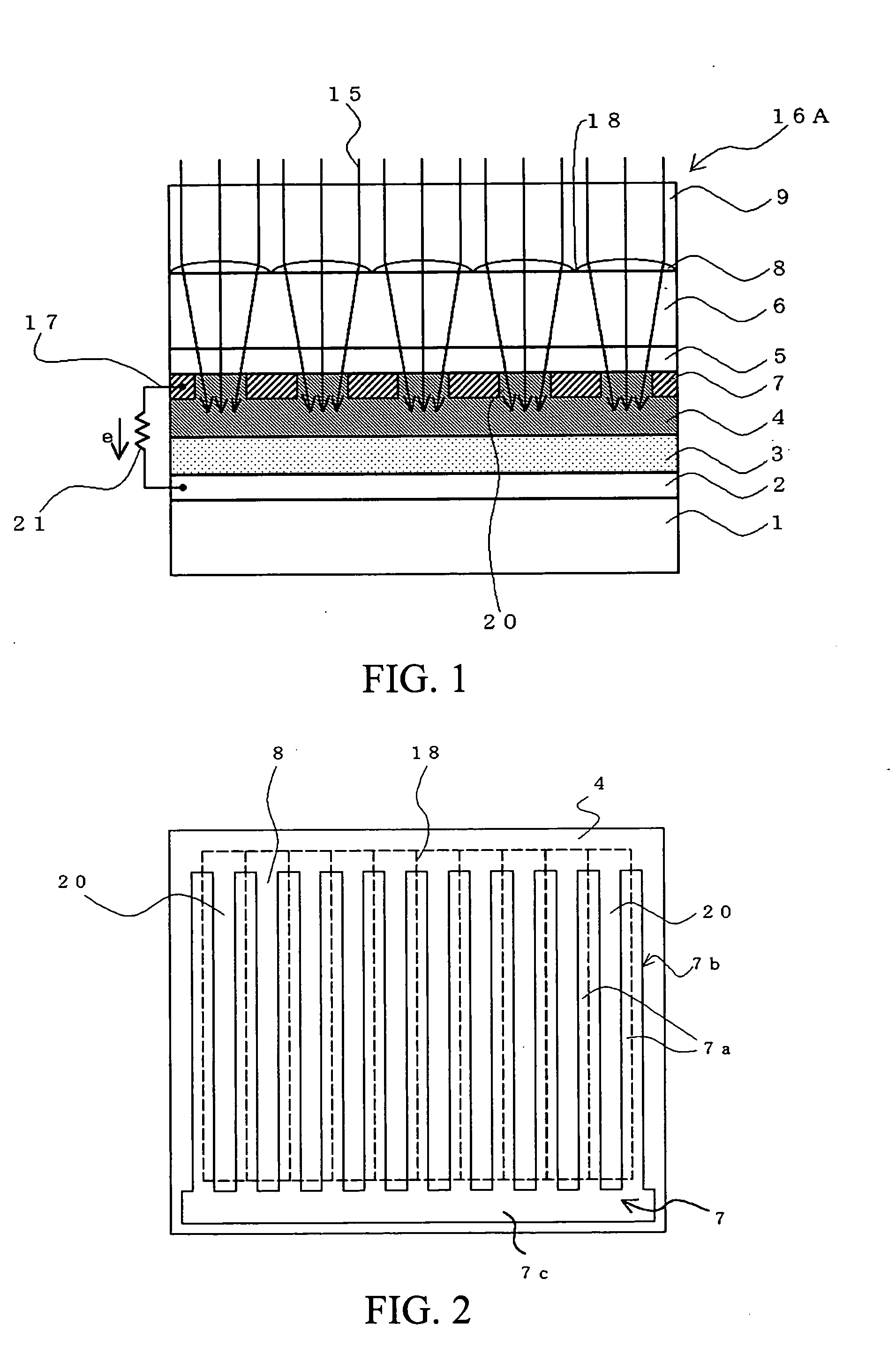Photoelectric conversion device
a conversion device and photoelectric technology, applied in the field of photoelectric transducers, can solve the problems of reducing photoelectric conversion efficiency, two problems cannot be solved simultaneously, and conductor loss, so as to improve mobility, reduce conductor loss, and efficiently enter the charge-separating means
- Summary
- Abstract
- Description
- Claims
- Application Information
AI Technical Summary
Benefits of technology
Problems solved by technology
Method used
Image
Examples
first embodiment
[0048] As shown in FIG. 1, in a photoelectric transducer 16A functioning as a wet solar cell according to this embodiment, a conductive layer 2 that is composed of, for example, ITO, gold, or platinum is formed on a substrate 1 composed of glass or a plastic by, for example, vacuum deposition, sputtering, chemical vapor deposition (CVD), or a sol-gel method.
[0049] An electrolytic layer 3 provided on the conductive layer 2 is composed of, for example, an electrolytic solution containing an iodine-iodide electrolyte and a mixed solvent containing acetonitrile and ethylene carbonate. The electrolytic solution contains, for example, 0.6 mol / L of tetrapropylammonium iodide and 5×102 mol / L of iodine.
[0050] A charge separating layer 4 includes a semiconductor sublayer such as an ultrafine TiO2 particle sublayer adsorbing a ruthenium complex, i.e., RuL2(NCS)2 (where L: 4,4′-dicarboxy-2,2′-bipyridine) functioning as sensitizing dye. This ultrafine particle sublayer is composed of sintered ...
second embodiment
[0071] As shown in FIG. 3, the photoelectric transducer 16B of this embodiment is as in the first embodiment, but the metal lines 7 are provided not within the charge separating layer 4 but on the transparent conductive layer 5.
[0072] According to this embodiment, the incident light 15 converging on the openings 20 between the metal lines 7 passes through the transparent conductive layer 5 and then efficiently enters the charge separating layer 4. Hence, electrons generated in the charge separating layer 4 can readily pass through the transparent conductive layer 5 and flow into the metal lines 7.
[0073] This embodiment can also achieve the same effects as in the first embodiment described above.
third embodiment
[0074] As shown in FIG. 4, a photoelectric transducer 16C of this embodiment is as in the first embodiment, but the transparent conductive layer 5 is omitted and the metal lines 7 is disposed at the middle along the thickness direction in the charge separating layer 4.
[0075] In this embodiment, light energy is not absorbed in the transparent conductive layer 5 by virtue of the absence of the transparent conductive layer 5. Hence, almost all incident light 15 can enter the charge separating layer 4.
[0076] Since the metal lines 7 are disposed at the inside of the charge separating layer 4, electrons generated in the charge separating layer 4 directly flow into the metal lines 7; hence, the conductor loss caused by the passage of the electrons through the transparent conductive layer 5 does not occur. In case where incident light is partially reflected by the metal lines 7, only a minimal amount of light is reflected. Furthermore, since photocarriers are generated by the reflected li...
PUM
| Property | Measurement | Unit |
|---|---|---|
| diameter | aaaaa | aaaaa |
| thickness | aaaaa | aaaaa |
| thickness | aaaaa | aaaaa |
Abstract
Description
Claims
Application Information
 Login to View More
Login to View More - R&D
- Intellectual Property
- Life Sciences
- Materials
- Tech Scout
- Unparalleled Data Quality
- Higher Quality Content
- 60% Fewer Hallucinations
Browse by: Latest US Patents, China's latest patents, Technical Efficacy Thesaurus, Application Domain, Technology Topic, Popular Technical Reports.
© 2025 PatSnap. All rights reserved.Legal|Privacy policy|Modern Slavery Act Transparency Statement|Sitemap|About US| Contact US: help@patsnap.com



